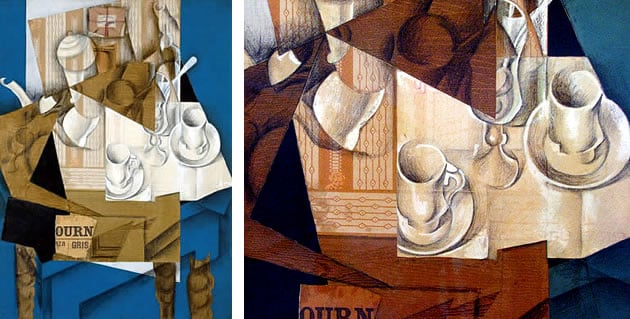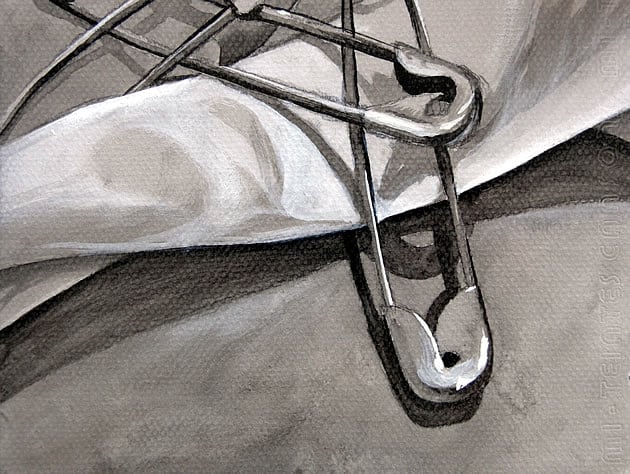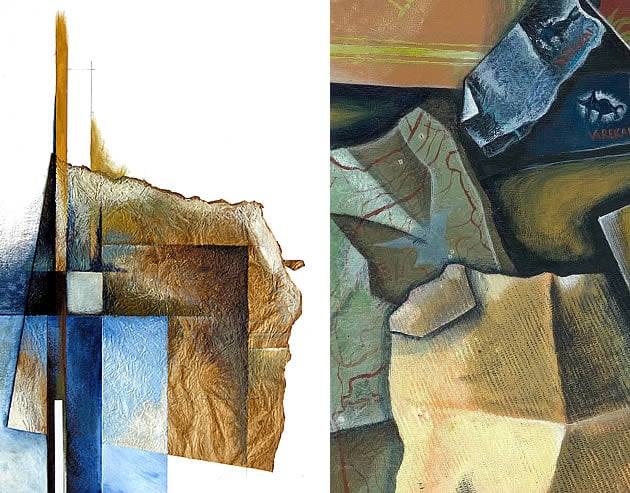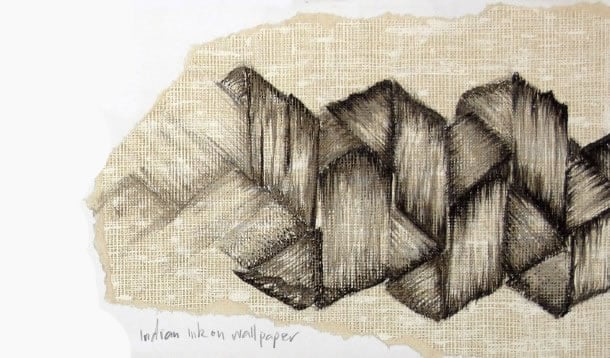Bagaimanapun, menambah-nambah bahan dalam karya tidak boleh dibuat sesuka hati ya.. perlu ada perancangan, kajian aspek formal sama ada kesan yang terhasil itu menepati tema yang cuba disampaikan.
Paint on something interesting
Time and time again I see students who paint or draw on white cartridge paper and nothing else. There is nothing wrong with cartridge paper. Some cartridge papers – especially thick, gutsy, wetstrength ones – are beautiful. Sometimes, a thin, flimsy sheet (the kind that warps at the mere hint of moisture) is all you need. But, often, experimentation and creativity with media brings considerable advantage. There is a joy –a wonderful aesthetic discovery – that takes place when you paint on something unexpected: a surface with history that brings with it colours, textures, marks and irregularities of its own.

Draw on coloured paper
The first thing you can do is embrace papers of other colours. Select those that integrate seamlessly with your coursework project (creams, browns, greys and blacks are likely to be more appropriate than psychedelic pink, for example).
Dark colours can be great for drawing on with light mediums; mid-tone papers (those that are a ‘medium’ tone – not too dark and not too light) are also excellent. As in theJuan Gris example above and the Indian ink work below, the colour of the paper acts as the mid-tone for the drawing; dark and light areas are added as required (this results in a piece that appears three-dimensional very quickly).


Embrace textured paper
There are lots of textured papers available. Some are machine made, pressed with a uniform mesh of bumps or grooves; others are handmade, with flecks of fibre, thread, tissue and other items intertwined within the paper pulp. If you don’t have access to textured papers, you can easily find or make your own. Tear apart packaging or disassemble things you find in the trash. Source whatever scraps you can and draw on them, or cut, tear and glue them into a painting.

Discover the beauty of drawing on tracing paper
Many people don’t realise that tracing paper is not just useful for tracing – it is an exciting drawing surface in its own right (see examples below by Debby Kaspari andMercedes Baliarda). Tracing paper can be used to make translucent overlays or glued onto white backing paper (be careful when gluing, as some tracing papers warp hugely when in contact with moisture). The shiny surface creates rich, glossy images that love to smudge and blacken your hands. Permatrace – a thick, waterproof drafting film – is particularly exhilarating: it produces some amazing outcomes with ink.

Use ripped, scrunched, folded, ripped, or stained paper or tissue
Tissue paper can be scrunched and glued onto a painting (shaping as required) to create a textural surface that can be painted over. As with other textures, dry-brushing will exaggerate them and make the fine web of creases more visible.

Paint or draw on patterned or textured wallpapers or other decorative surfaces
Care needs to be taken when integrating patterned items; it can be easy for the pattern to dominate and overpower a work. When appropriate imagery is selected, however, patterned items can provide excellent drawing surfaces or collaged material.

Integrate newspaper cuttings
If you experiment with drawing on newspaper, remember that the text becomes a part of your work; this needs to be an intentional and considered decision. If the words are legible, the message contained within the writing should be relevant or, at the very least, not distracting.
Example by Jonathan Derby:

Draw on book pages, pieces of rubbish or other text-based items
Many artists are achieving great popularity for their drawings upon found, text-based materials.
Examples by Mark Powell and Paula Swisher:


Draw on cardboard
While MDF or hardboard is a great surface to paint on, those who have to send away work to CIE are limited by weight restrictions. Cardboard is a suitable, lightweight replacement. Card can provide a sturdy base for a painting and, when cut-outs are glued into a work, can create elevated surfaces that segment a composition, adding depth and shadows.

Example by EVOL:

Paint on linen, hessian, canvas or fabric
While stretched canvases are unable to be posted to CIE, pieces of fabric can be cut and glued onto paper and painted upon. The fine mesh of woven thread can be left as is or hacked at and unravelled, fine threads spiralling into the artwork. It is also possible to ‘stretch’ canvas yourself over a sturdy piece of cardboard, with the canvas edges folded behind the back of the card and stapled.
Example by Tony Fomison:

Go wild with modelling compound
Modelling compound – used for creating thick, sculptural elements in an artwork – often becomes a Painting student’s best friend. Whether used with masking tape to create straight edged areas, or slapped on and scratched erratically with a stick, modelling compound is the stuff of magic. Items can be pressed into it and carefully lifted out when dry, revealing an indented pattern and form; it can be sanded and cut with a craft knife when dry.
Example by Amiria Robinson (left) and Jessica Fong:

Throw in everything else
If all of the above fails to inspire, create an assemblage of objects not normally associated with making art (example by Robert Rauschenberg). If you have to send your work overseas for moderation and/or assessment, bear in mind that your options are limited by what is able to be shipped through customs (for example, not organic matter, such as bark or leaves) and by what is small, light and cost effective to post (i.e. not steel sheets). Even with these limitations, however, there are many possibilities.

When you shape or create a painting surface, there is something of you invested in the work, before you even begin.
Penghargaan kepada penulis iniThis article was written by Amiria Robinson. Amiria has been a teacher of Art & Design and a Curriculum Co-ordinator for seven years, responsible for the course design and assessment of Art and Design work in two high-achieving Auckland schools. Amiria has a Bachelor of Architectural Studies, Bachelor of Architecture (First Class Honours) and a Graduate Diploma of Teaching. She is a CIE Accredited Art & Design Coursework Assessor. Follow Student Art Guide on Pinterest, Facebook or Follow Amiria on Google+

ifonya sangat menarik dan sangat kren bos...
BalasPadammantap lh pokoknya bos...
lanjut trus postingan ya bos...
cantik - cantik gambarnya bos,,,, keren.....
BalasPadam( - ) vmenplus ( - )